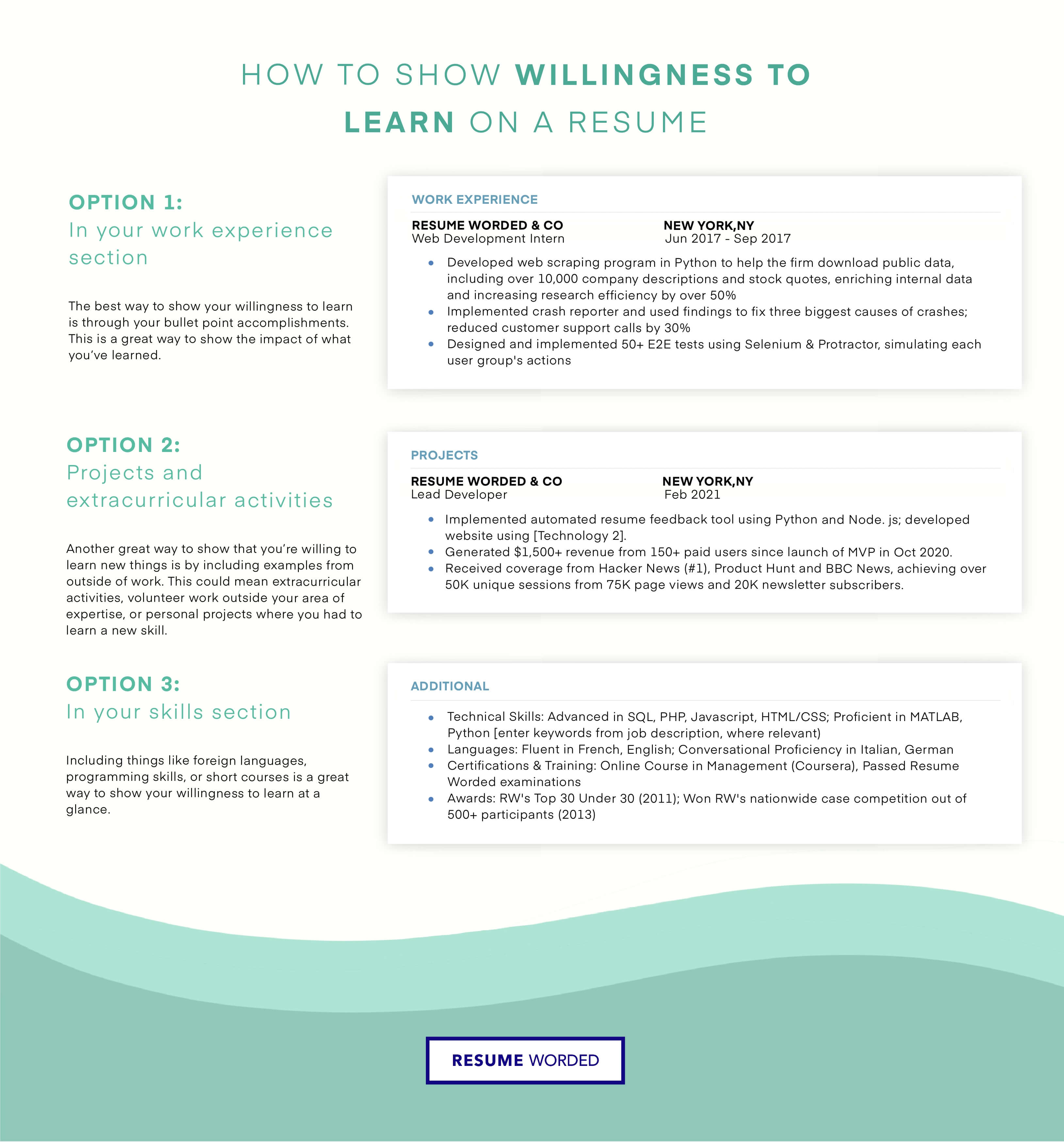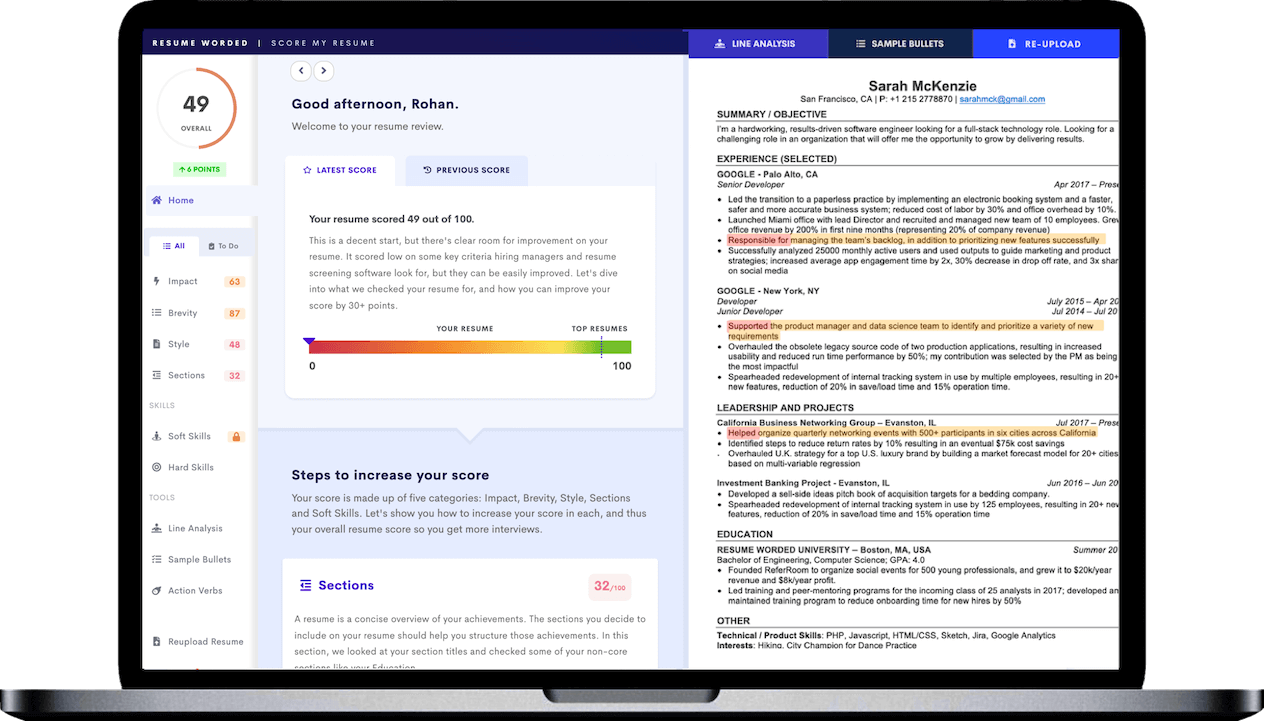“Experience not necessary, but must be willing to learn …”
Have you ever seen that on a job description and thought, “that’s me?” Or stumbled across a posting for a job you know you can do well, even if you don’t quite meet all the requirements?
The good news is, that job doesn’t have to be out of reach. The bad news? It takes a little finesse — and no, that doesn’t mean writing “I’m eager to learn” on your resume.
Here’s what it does mean.
How to say you’re willing to learn on a resume
- Take a good look at the job description. What skills or experience are listed on the posting that you don’t already possess?
- Now be realistic — are those absolutely essential (like legally mandated qualifications) or are they things you could easily pick up on the job?
- Even if you don’t have that exact skill, you may have done something similar before. Brainstorm any skills or experience you have involving a similar role, industry, or skill set, even if it’s not an exact match.
- Think about other times you’ve learned something new, picked up a new skill, or hit the ground running without any experience. These are the key to proving your willingness to learn!
- Now frame that experience in terms of accomplishments by starting with a strong action verb and ending with clear numbers or metrics (scroll down for resume bullet point examples to get you started).
- Add in a section for skills, projects, or extracurricular activities for more evidence of times when you’ve learned something new.
- Check your resume against an ATS resume scanner for feedback on soft skills like willingness to learn as well as suggested bullet points and essential keywords.
Where to put eagerness to learn on a resume
You can showcase your willingness to learn in a few different ways on your resume. Some of the best places are:
- Work experience bullet points
- Projects and extracurricular activities
- Skills
Work experience bullet points
The best way to demonstrate any soft skill — like willingness to learn — is in your bullet point accomplishments. This is a great way to show the impact of what you’ve learned, which is what recruiters care about the most.
Essential Tip: Quantifying your accomplishments is the key to making them stand out. It’s fine to include a rough estimate even if you don’t have exact figures.
I’d recommend uploading your resume to the tool below to find out if your bullet point accomplishments highlight your willingness to learn and other soft skills relevant to the job you’re applying for.
Projects and extracurricular activities
Another great way to show that you’re willing to learn new things is by including examples from outside of work. This could mean extracurricular activities, volunteer work outside your area of expertise, or personal projects where you had to learn a new skill.
Essential Tip: Everything on your resume needs to add value. Only include projects and activities if they add something that’s missing from your main work experience section.
Skills
How do you show that you’ve learned a skill? By putting it in your skills section! Including things like foreign languages, programming skills, or short courses is a great way to show your willingness to learn at a glance.
Essential Tip: Your resume skills section is for hard skills only. Don’t ever list soft skills like “willingness to learn” in your skills section (or anywhere else on your resume).
If you’re wondering which skills belong in your skills section, use the tool below to search for the job you’re applying for and it’ll give you a list of relevant hard and technical skills.
Do’s and don’ts of putting willingness to learn on a resume
Before we dive into some resume examples, here are some key takeaways for putting eagerness to learn on a resume.
DON’T: Say it outright. The phrase “I’m willing and eager to learn” has no place on your resume.
DO: Stick to the facts — that is, accomplishments that show how you’ve handled learning new things in the past.
DO: Apply for jobs you’re not 100% qualified for. In general, aim to meet around 80% of the job requirements listed.
DON’T: Expect to impress recruiters solely with your eagerness to learn. Hiring managers expect everyone to be willing to learn! Someone who doesn't want to learn anything probably isn’t applying for a job in the first place.
DON’T: Include every skill you’ve ever picked up in your skills section just because it shows that you’re willing to learn new things.
DO: Curate relevant skills, projects and activities to round out your resume and fill in any blanks that aren’t covered by your professional work history.
“Willing to learn” synonyms for your resume
So, how can you say you’re eager to learn on a resume without coming right out and saying it? With clever action verb synonyms like:
- Learned
- Revised
- Interviewed
- Surveyed
- Clarified
- Discovered
- Researched
- Investigated
- Analyzed
- Solved
- Examined
- Reviewed
- Tested
- Devised
- Verified
- Processed
- Attained
These action verbs all focus on your willingness to investigate new concepts, evaluate and improve your own understanding, and seek out help when needed, which are all essential components of being willing to learn.
Willingness to learn resume examples
If you really want to show that you’re willing to learn new things on your resume, don’t just stick to showing off your skills. What hiring managers are really looking for is evidence of how you’ve applied that learning to the company.
Here are some examples for you to follow that will help you do exactly that.
Implemented crash reporter and used findings to fix three biggest causes of crashes; reduced customer support calls by 30%.
Instead of focusing on what you don’t know, provide examples of things you’ve learned in the past and how you did it. This shows recruiters that you’re willing to learn new things and provide solutions to problems.
Designed merchandising strategies for grocery retailers based on regression analysis identifying key store attributes to increase traffic and conversion; resulted in a 25% sales lift.
Don’t provide a list of new skills you’ve learned — show the steps you took to learn them. By walking a hiring manager through the steps you took to find something out, they have a better understanding of how you’d learn new things in this role.
Translated business questions into use cases and data model requirements with emphasis on anticipating future ad-hoc needs.
Learning new things isn’t just about being reactive — it should be proactive, too. Don’t just include examples of when you learned something new in response to a problem — show how you’ve anticipated future needs and been willing to learn in advance.
Designed and implemented 50+ E2E tests using Selenium & Protractor, simulating each user group's actions.
Sometimes, being willing to learn new things is about changing the way you think. Understanding different perspectives and thinking outside the box are important transferable skills that will serve you well in nearly any role.










